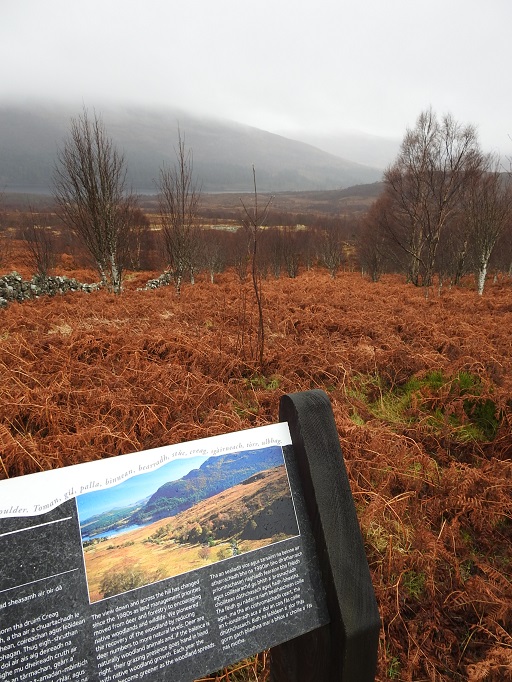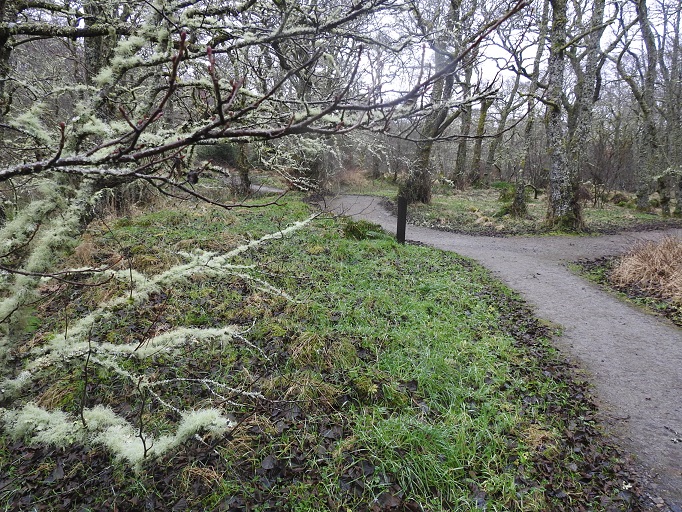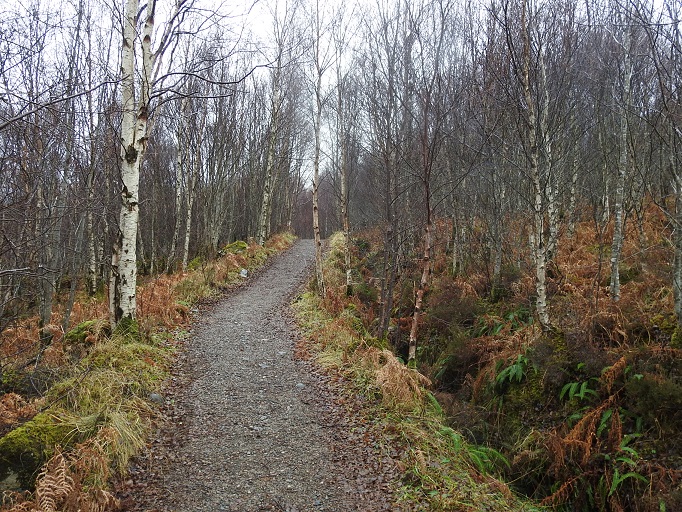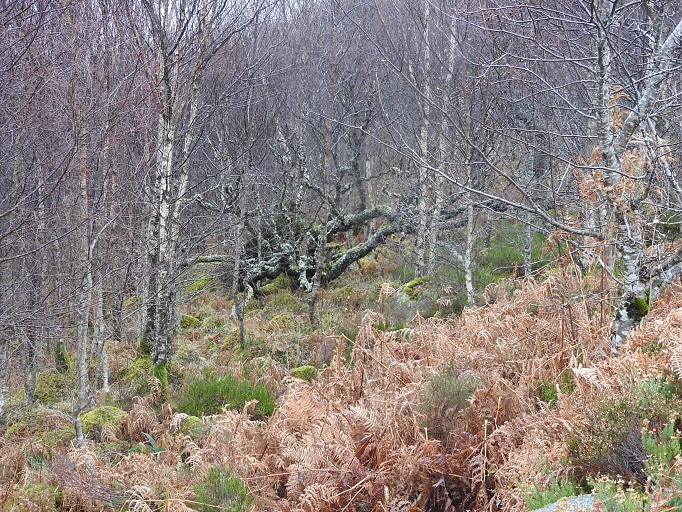A winter’s day
In a deep and dark December
Is what it was for most of December. Dreich was the word to describe it.

What better kind of day for a trip down memory lane?
I first climbed on Creagh Meagaidh in the early 1970’s. The place gripped me from the start. The location was, well odd. Midway twixt the Ben and the Cairngorms, you walked in from a nondescript car park by Loch Laggan, taking a diagonal line up and rightwards from Aberarder till the path evened out on a long slow left through some ancient scattered birches, and the wonderful immensity of 1500 feet of snow and ice plastered schist came into view. Heroic deeds were done in those days. Not by me. I did a few of the classic climbs, spent some alcohol infused nights in the howff, and even became benighted on the walk out one time. That four mile walk in and then out intrigued me.
In 1986 control of the land in that area went to the government, in the shape of what is now Scottish Natural Heritage. They immediately implemented what was billed as a radical plan. All sheep were removed almost immediately, and the deer population was hugely reduced, to about 10% of the then current level. I believe the expectation was that the ancient birches would gradually put out seed and regeneration would take place. However, it was only a year or two later that rowan saplings started appearing. Logical really. Winter thrushes eat the berries, and they crap out the seeds, all in their own pellet of natural fertiliser. The saplings thrived with few herbivores, and it was not long before young birch trees started peeking out from the heather.
I took a walk up into Coire Ardair, must have been 1994 or so, with that great naturalist Dick Balharry, and a film crew. On the walk in the new saplings were already person high, there were black grouse and ring ouzel around. We found a tiny birch sapling right up by the lochan. Clearly the trial was proving a success. I am sure I must have been up there climbing in the winters to follow, but just noticed a few more young trees. So, fast forward a few years to a Saturday last month, when this old git took a handful of painkillers, grabbed his walking poles and camera, and hit the road to Meagaidh.
 The track has been upgraded, but what was a trek through open ground is now a forest walk.
The track has been upgraded, but what was a trek through open ground is now a forest walk.
 I went up to about the 400m contour, where some of the old birches are still hanging in, dominating, but only for a few more years before the new growth takes over.
I went up to about the 400m contour, where some of the old birches are still hanging in, dominating, but only for a few more years before the new growth takes over.
 There were birds around too, mixed finch and tit flocks, and a few thrushes. Most Scottish uplands are devoid of wildlife at this time of year. The lichen growth on the old trees by the burn looks more substantial than I remember too, perhaps an indicator of increasing rainfall?
There were birds around too, mixed finch and tit flocks, and a few thrushes. Most Scottish uplands are devoid of wildlife at this time of year. The lichen growth on the old trees by the burn looks more substantial than I remember too, perhaps an indicator of increasing rainfall?
So, this is rewilding. A dramatic change in only 30 years. And please note politicians. No trees have been planted – well, maybe a few of the new Scots pines have, there being no relict population. Just remove or control the destructive herbivores and leave it to the birds. And nature.
One has to ask now why Cairngorms Connect is establishing tree nurseries? We are talking lowland with plenty of established trees, we have the model established by the RSPB at Abernethy, (and even at Knepp in Sussex, so well described in “Wilding”) i.e. control deer, bring in cattle, let the scrub grow first. If we need planting anywhere, surely it is at the higher altitudes, helping the montane scrub to re establish?

The number one lesson to learn from the Creag Meagaidh experience is that a similar expansion of native woodland can be achieved over vast tracts of the Highlands over the next 20 years. In many areas all that is required is to reduce grazing pressure by bringing deer density down to less than 5 deer per sq km, without fencing, as soon as possible. And the first people who need to learn this lesson are the Royal Family and those who are responsible for the management of Balmoral Estate. The repeated failure of this estate and other members of the South Grampian Deer Management Group to comply with the requirements of two successive deer voluntary control schemes from 2003 to 2019 tells you everything you need to know about the need for compulsory culls. These need to be led by the Scottish Government, over most large estates in the Highlands. When will these landowners ever learn that there is a climate emergency and land use changes are essential, even on Balmoral. Got it?
Dave, do you think the report recommendations answer your points?
https://www.gov.scot/binaries/content/documents/govscot/publications/corporate-report/2020/01/the-management-of-wild-deer-in-scotland-deer-working-group-report/documents/the-management-of-wild-deer-in-scotland-deer-working-group-report/the-management-of-wild-deer-in-scotland-deer-working-group-report/govscot%3Adocument/Deer%2BWorking%2BGroup%2Bfinal%2Breport%2B-%2B19%2BDecember%2B2019%2B-%2Bpublication%2Bnumber%2B%25281%2529.pdf
Thanks for the prompt, Eric. No, the Pepper report does not answer the problem – it contains fine aspirations to reduce deer numbers and a very good analysis of the legislative journey which has brought us to this point, but the report has its limitations, perhaps as a consequence of Simon’s death. This curtailed the studies which the Deer Working Group intended to carry out in other European countries and to see what lessons could be learned for Scotland. I think a follow up study is now needed to supplement the Pepper report. So the Working Group has had to limit itself to using the existing legislative framework, originally established in 1959, to guide its present recommendations. These should provide a good guidance to the Scottish Parliament on how to make legislative tweaks or new policy initiatives between now and the end of this Parliamentary term. Then we should be looking to a new Deer Scotland Act in the next Parliament from May 2021 which combines the best of Scottish with mainland Europe experience. Meanwhile we will probably stagger on with most landowners behaving as though it is business as usual and deer densities not coming down far enough to meet natural heritage and other public values. I am just preparing a post for parkswatchscotland on this. Look forward to discussing the options with you!
its simple – plant trees where there is no ‘seed rain’ of all the species trees which should be there (as per evidence), so its right to plant trees in many parts of Scotland. It does depend on how long you are prepared to wait and if soils need disturbance to allow seeds to germinate, so scarifying pigs may be required. Might have to weed out spruce regeneration as well. Love Creag Meagaidh!
Hugh, I basically agree but think Creag Meagaidh shows its more complicated than that. Dick Balharry never anticipated the Rowan would come back as quickly as it did as their seed was carried by birds. I will post on this sometime but in the southern hemisphere quite a lot of work has been done about how seed is carried by birds and animals and that means trees can appear where there is no obvious seed source. I believe therefore we should keep rewilding as wild as possible and just because a species is thought missing, we should not rush to plant it but rather wait and see what happens.
Does the Scottish Parliament do excursions? It would do them good to get to Creag Meagaidh or Glen Feshie or Abernethy or Carrifran or other rewilding sites. Reforesting Scotland tried to get MSPs out on our 4 Land Revival tours but we couldn’t get them along. Is Holyrood really so cosy?
Hi Donald, excursions by the Scottish Parliament – absolutely! People should also ask their MSPs (constituency and list) to come for a walk – I have one in the pipeline! But I think we should aim higher and remember that John Muir, a Scot, got Theodore Roosevelt to spend three days camping and stravaiging with him in Yosemite – that led to the creation of National Parks in the USA. Think what a 3 day stravaig across the Cairngorms, from Glen Feshie to Balmoral would show Nicola Sturgeon or Roseanna Cunningham, the Cabinet Secretary for the Environment: the transition from the largest and most ambitious rewilding project in the British Isles to the destructive consequences of excessive deer numbers and muirburn on the natural environment
Good point Nick. Remember David Attenborough took Barak Obama “wild camping” (how I dislike that misused term now). The “Today” programme is devoting time to the subject of trees this year. Must invite Nick Robinson et al up for a wee walk.
I`ve visited Creag Meagaidh pretty regularly over the near 50 years I`ve been around here.Undoubtedly it`s a great success but,goodness,it took a long time for the trees to get going. In view of the climate emergency is there not a need to intervene.
At a few sites around Kingussie there is a great deal of regeneration.Is that “natural” if the seeds come from plantations of pines, Sites include at Creag Beag -487m-just behind Kingussie where tree seedlings are increasing right to the top and on the old military road W of Ruthven Barracks. This tree growth does not appear to be on estates taking a strong deer control policy but I`m told that sheep numbers have dramatically dipped because of market forces.
Feshie is looking good but a walk up from Ruighe Etchacan to Lochan nam Bo quickly reaches tha area where there is little regeneration..
A walk up to the plantation that`s maturing by Kingussie golf course can yield sightings of a wide range of bird species,the usual tits,bullfinch, wrens etc but more recently jays,crossbills.. and of course there are lots of red squirrels..
I`m not arguing agin rewilding but I do thinkj that sometimes debates are becoming too polarised..
Is the idea that a commercial crop of trees provides the raw material for a bio alternative to plastic wrapping a bad thing..?Where will these trees be acceptable?